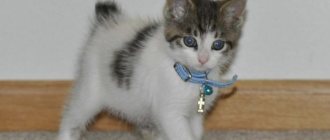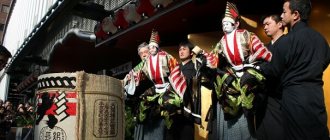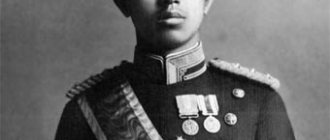Maneki neko is a famous Japanese talisman that brings good luck. He has other names - money cat, cat of luck, cat of happiness and others. This phrase is translated as “alluring cat” or “attractive kitty.” The talisman received this name for a reason. It represents a cat with one of its paws or both paws raised at once. Such a gesture attracts good luck and allows you to keep it.
Some cats hold a koban in their paw, which is a gold coin that was in circulation during the Edo era. This coin has a face value of one ryu, but this value is too small for a talisman of money and good luck. The cat's money has a value of ten million ryu, so that like will attract like.
Such cats or seals come in different colors and are made from different materials. They need to be installed in a specific place in the house. Only under this condition will they bring good luck and attract money.
Legends of the origin of Maneki-neko
There are many different legends about the origin of the symbol of a cat with a raised paw. All of them are stories related to Japanese history.
The priest's cat who saved a man's life
A Maneki-neko figurine with a fish in hand will help improve your financial situation.
A long time ago, a rich gentleman was traveling with a detachment of samurai on state business. He passed by the Gotoku-ji Temple, which at that time was experiencing financial difficulties. It was raining heavily. The master, or as it was commonly called in those days, daimyo, hid from the rain under a spreading tree. Suddenly he noticed a cat that belonged to the priest from the temple. The animal waved its paw, as if calling on the daimyo to follow it. The gentleman was very surprised - the gate was old and invisible in the dense thickets. If there had not been a four-legged savior, no one would have paid attention to the entrance to the temple. The daimyo came out from under the tree, walked a few steps, when suddenly lightning struck his shelter.
So the cat saved the life of a rich gentleman, who subsequently became friends with his owner and began to help the temple with generous donations. After the death of the cat, the daimyo ordered that a figurine be made in his honor. This is how the first Maneki-neko mascot appeared.
Courtesan cat
Black Maneki-neko will protect its owner from the evil eye and evil spirits.
In the early seventeenth century, brothels were popular in western Tokyo. At one of these high-class establishments there was a badass named Usugumo, who was incredibly fond of furry four-legged friends. There were always several pets next to her, but only one cat was the most beloved.
One day, Usugumo woke up late at night with the desire to relieve herself. She stood up, but suddenly her pet grabbed her kimono with her claws, hissed and tried not to let Usugumo go further than her room. The establishment's guard came running in response to the noise. He decided that the cat had gone mad and cut off its head. The head flew up to the ceiling from the impact and grabbed the snake that was hiding there with its teeth. So, after death, the cat saved its owner’s life.
Usugumo was very homesick for her pet. In order to dispel her sadness, one of the regular visitors gave her a figurine of a cat, which became the prototype of the Maneki-neko known today.
The story of the cat from Imado
Green maneki-neko helps strengthen concentration and memory.
One poor elderly woman from Imado, which is located in the eastern part of Tokyo, was left alone in her old age. She was forced to sell her pet cat to earn some money for food. But after a while the funds ran out, and the old woman found herself in a difficult situation.
One night she dreamed about her cat. He spoke to her: “Go make a figurine that looks like me and sell it to people.” The old woman obeyed and began making figurines from different materials. People liked her figurines, they were quickly sold out. In this way, the elderly woman was able to raise money and provide for herself for the remaining years. And the figures made by her hands acquired the halo of a talisman of good luck and prosperity, becoming the Maneki-neko amulet known to us.
Theory about the symbolic meaning of Maneki-neko
Some sources claim that the symbol appeared quite prosaically - a cat with a raised paw symbolized a courtesan luring her into cheerful neighborhoods. Theoretically, in ancient times, the authorities prohibited the use of a special symbol, and to circumvent this law, the courtesan houses came up with the Maneki-neko sign.
Color solutions
The traditional color of the paw-raised mascot is white fur with spots of yellow and black. However, along with it you can often find different color solutions:
- a white cat without spots is the second most popular, the meaning is purity,
- black cat - especially popular among women, meaning - allows you to scare away evil (envious people),
- red color – wards off diseases and evil spirits,
- golden cat – is directly related to financial well-being,
- pink cat - gaining popularity, meaning - success in love,
- blue color – gives peace,
- yellow cat - protects marriage,
- green cat - brings wisdom.
RECOMMENDED: Symbols for attracting wealth, luck, prosperity
№1 Siamese cats
Siamese cats
The homeland of the Siamese is Thailand, which was formerly called Siam (hence the name of the breed). Therefore, sometimes representatives of this cat breed are also called Thai.
This is a very ancient breed. Usually it was maintained only by rich and influential people. It was believed that Siamese cats are the guardians of the souls of kings, who retain their strength and grace. Therefore, people believed that Siamese brought success and prosperity.
Popular articles now
Meladze's mistress Erica Herceg in a miniature top showed what attracted him
The star of “The Magnificent Century” Meryem Uzerli took to the red carpet in a dress that went down in history (PHOTO)
The girl has grown up: Masha from “Daddy’s Daughters” boasted a luxurious figure in a transparent blouse
Mesh and two ribbons: Erica Herceg showed a very candid photo in a bodysuit - Meladze does not find a place because of jealousy, and Brezhnev is hysterical (PHOTO)
show more
Why does Maneki-neko have a raised paw?
The Maneki-neko symbol can be found in different interpretations, and each of them has its own meaning. There are three options in total:
- a cat with its left paw raised is a symbol of calling people, the desire to communicate;
- raised right paw - Maneki-neko calls good luck and cash flow into the house;
- If a cat has both front legs raised, it attracts both people and material wealth.
A cat with its left paw raised symbolizes goodwill, openness and a desire to communicate.
There is a theory according to which the height of the raised paw affects the ability of the Maneki-neko to perform its task - the higher it is located, the better it attracts the necessary energy.
Maneki-neko: general information
Maneki-neko is a Japanese good luck charm in the form of a kitten with its paw raised.
The appearance of the talisman is associated with Chinese wisdom, which says: “If a cat washes itself, expect rain.” The weather, as suggested in this proverb, will lead to the appearance of guests in the shop, who will go there to dry off and warm up, and therefore the bargain will go better.
The literal meaning of cat behavior has become figurative, and now if the animal is washing itself, one should wait for buyers.
Homeland of the figurine
Such cat figurines originated in Japan during the Edo era, which lasted from the beginning of the 17th century. to the middle of the 19th century. The first written mention of them dates back to the 50s. XIX century, presumably at the same time the image appeared.
Cat mascots are also popular in the Middle Kingdom, which is why in Western countries they are associated with Chinese establishments, not Japanese establishments. That’s why some people mistakenly call maneki-neko “jinmao” (“golden cat”).
Japanese Bobtail
This rare breed with a short tail is considered a symbol of happiness in many cultures. Bobtails are intelligent, friendly and playful creatures. They can be extremely cautious with strangers, but they will always find a common language with their family members and will give them their love and care. For the Japanese, the bobtail has always been a symbol of happiness. The Japanese believe in the power of black and red animals. They are the ones who can bring prosperity and success to their owner.
It was previously reported which breeds of cats are considered the most loyal to their owners.
The meaning of the Maneki-neko figurine
There is another version of the origin of the magic symbol. She is quite matter-of-fact.
The cat is the personification of the Japanese courtesan, geisha. And a raised paw is a symbol of inviting a man into the house. One way or another, the figure is associated with fun, luck, and luxury. This meaning has been retained. The talisman is credited with the ability to attract success and prosperity into the life of the owner.
But the exact value also depends:
- from the color of the figurine;
- from the posture of the animal;
- from the object that the cat is holding in his hands.
There are amulets made in the shape of a cat that prolong life and guarantee longevity. Other figures are associated with attracting wealth and financial well-being. The variety of variations makes it possible to choose the symbol that seems most suitable.
Varieties of mascot
The Japanese Maneku cat comes in many varieties: some are pure white and raise one paw, while others are multi-colored and hold various objects in one paw. The following are considered the most popular:
- White cat with one raised paw. Such a talisman helps in the desire to develop intellectually, maintain mental balance and bright thoughts.
- Royal cat with a money hammer in one of its paws and a scarf. In this case, Maneki-Neko is intended for representatives of leadership positions. The gavel symbolizes good luck, and the scarf symbolizes prosperity.
- Warlike Maneki-neko - the figure is dressed in a multi-colored kimono, and kittens with raised paws are sitting on the shoulders and head. Such a talisman is configured to protect its owner energetically and physically. Interestingly, the number of additional cats enhances the power of the main Maneki-neko.
- Black Maneki-neko - creates a protective aura around its owner from the evil eye, evil spirits. The raised left paw calls on good spirits for protection. Sometimes the black cat is holding a coin (a sign of success) and wearing an apron (a protective garment).
- Red Maneki-neko. Removes illness and negative energy from the owner. The raised right paw attracts light energy to the owner to restore his energy charge. Just like the black cat, he often holds a coin in his paw and wears an apron.
- The money cat, like the well-known money frog, traditionally holds in its paws a bag of coins or one large old-style coin.
- Blue Maneki-neko symbolizes chastity and stability of morality. Promotes spiritual development, gaining control over one’s own emotions and inner harmony.
- A cat with raised front paws is used to protect the hearth and family. If human babies are sitting on a cat's lap, this is also a symbol of fertility.
- A pink cat helps to dispel the aura of loneliness and transform its owner in the eyes of others, making him more attractive. The talisman helps get rid of melancholy, blues, and strengthen self-confidence. It also enhances sexuality and external attractiveness for the opposite sex. The amulet can be used both to acquire new relationships and to renew and strengthen existing ones.
- Green maneki-neko helps strengthen concentration, memory and develop creativity. The talisman helps to retain the information received in your head. It will be useful not only for students, but also for creative people - researchers, scientists and writers.
Warlike Maneki-neko - a cat in a multi-colored kimono with kittens.
Such a talisman will protect its owner energetically and physically. A cat can hold a variety of objects, and each of them has its own meaning.
- fan - brushes away evil spirits;
- children's toy - wish fulfillment;
- a gold coin or fish - for money;
- flowering twig - attracting love;
- fruits - helping spouses conceive a baby;
- oar - success in any endeavor;
- hieroglyphs - each hieroglyph has its own translation.
Sometimes a red pillow is placed under the figurine to attract money.
In Japan, mascot distributors always recommend purchasing a white kitten with multi-colored spots with its left paw raised. They say that such a talisman speaks to all guests about the spiritual purity of the household, and with its paw it attracts happiness into the family.
DIY Maneki Neko talisman
In order to make Maneki Neko with your own hands, you will need baked plastic in white or any other color chosen in accordance with the selected value. Options made from self-hardening plastic or papier-mâché are also possible.
To work you will need the following tools and materials:
- foil,
- stack,
- transparent glue “Moment”,
- cotton buds,
- toothpick,
- acetone,
- marker for plastic (black),
- brush,
- paints for ceramics (yellow, black, red),
- artistic acrylic (gold),
- plastic varnish (transparent),
- bell,
- Red ribbon.
According to the presented master class for making a figurine with your own hands, the cat will turn out to be small, so you can do without using foil filling, which is often used for large products. From plastic of the selected color you need to form 4 large, 3 smaller and 3 small elements. The larger parts will later develop into the body, head and hind legs. The smaller pieces will become the tail and front paws, and the small pieces of clay will become the ears and the coin.
Each part of the figurine is given a shape, after which a rough connection of the ears to the head, paws and coin to the body is created. Next, each resulting element is detailed. One of the paws is raised. In this case it is the right paw. Such a cat will attract money and good luck.
Small details (hieroglyphs, nose, claws) can be molded or drawn. Next, using a toothpick, a hole is made for the future connection of the head and tail with the body, but the gluing itself has not yet been carried out. Then preparation for baking begins, for which the foil is folded several times, and all the individual parts are placed on it.
RECOMMENDED: 14 rules for an ideal living room according to Feng Shui
The cat will be baked for about 30 minutes at 100 degrees in the oven (or according to the instructions included with the plastic). To dry the self-hardening plastic and papier-mâché, you can put the figurine in the oven for 2-3 hours at a temperature of 70 degrees. After the oven, you need to wait for the cat to cool completely.
After cooling, the unconnected parts are glued together. If there are dirt on the figurine, you can get rid of them with a cotton swab dipped in acetone. Having cleaned the surface in this way, you can begin painting. Using paints on ceramics, details of the cat's face, claws, bib, spots on the paws and tail are drawn.
The coin is painted with gold acrylic, and the hieroglyphs are applied with a marker. A red ribbon with a bell is glued to the place of the collar. After the paints have completely dried, the figurine is varnished.
History of appearance
There are several versions about the appearance of the Japanese maneki-neko cat.
In ancient times, the abbot of one of the Japanese temples sheltered a cat. The sanctuary itself was in a deplorable state, since no funds were allocated for its repair, which the minister complained about, talking to his cat as if he were an equal. One day a prince drove past the temple. A terrible thunderstorm broke out, and he decided to wait it out near a large tree. As soon as he hid under the crown, he noticed a cat waving
him with his paw.
Surprised, the prince went to the call, and immediately lightning struck the tree, smashing his shelter into splinters. In gratitude
For the rescue, the prince donated a lot of money to restore the monastery. This temple has survived
to this day, and in the first days of spring,
a ceremony
of gratitude is held in it in honor of the Japanese cat Maneki-neko.
According to another version, such a cat saved its owner from a snake at the cost of its own life. Noticing the approach of the creeping reptile, she attacked the girl. A security guard came running in response to the noise and cut off the cat’s head; it flew to the very ceiling, where it bit the snake to death. A cat figurine given by one of her friends was able to console the sad girl.
The third story is about an old woman who, due to poverty, had to drive away her cat. In a dream, an animal came to her and advised her to make a clay figurine and sell it. That's what the woman did. With the money she earned, she supported her assistant and lived in abundance herself.
It is not known for certain which version is the most truthful. But the popularity of the amazing maneki-neko (Japanese beckoning cats) continues unabated to this day.
Appearance and meaning
The main difference between a magic cat and its fellow cats is its red collar. It is connected with the long-standing custom of wearing a red collar with a bell so that pets do not get lost. In those days, cats were elite animals, and rich ladies valued them and were afraid of losing them. The red decoration indicated that the animal was under guardianship and punishment awaited the one who caused harm to it.
According to legend, a Chinese cat with its paw raised invites good luck and happiness to the house where it stands. It is believed that the higher it is raised, the more valuables it can bring.
- the raised right paw invites guests, customers, communicates and is not associated with receiving money;
- the left one invites material values into the house;
- both feet up is a compromise solution for the financial and spiritual components of life.
Figurine color
In earlier times, figurines were not so varied in color. The traditional ones are tricolor, black, red and red. Nowadays, an expanded palette of colors is used to paint figurines, where each color is responsible for one of the areas of life.
- white - chastity and innocence, a symbol of pure thoughts and virtue;
- black - drives away bad people, scares away evil, takes trouble away from home and protects from spirits;
- red - will protect against illness and protect the family hearth;
- pink - will help you find love;
- green - easy comprehension of knowledge, trains memory and develops thinking;
- gold is the color of wealth;
- blue or dark blue is a shade of wisdom and peace of mind.
Objects in paws
Happy cats often hold all sorts of objects in their paws. Depending on them, maneki-neko have different effects.
- golden boar - a coin of one “Re” in those days was the largest denomination, therefore it means untold wealth;
- red carp - wisdom;
- goldfish - money and fulfillment of all desires;
- fan - protection of the house from evil influences;
- fruits - a lot of kids;
- cherry blossom branch - love;
- daruma (tumbler) - wish fulfillment.
The figurines come with open eyes and closed ones; this is also worth paying attention to when choosing a souvenir. Maneko the cat looks into the foreseeable future with an open mind and is aimed at achieving goals in the near future. Closed eyes - responsible for far-reaching plans.
Origin story
The exact time of origin of maneki-neko remains unknown. Several legends are associated with its origin, each of which is popular and interesting in its own way. What unites them is that the main character in them is a cat, and the figures appeared in memory of her act.
The priest's cat who saved a man's life
In the suburbs of Tokyo there is Gotokuji Temple. One of his monks began to take care of the cat, whom he named Tama. One day Tama was sitting near the temple and washing his face, and at that time he was seen by the head of a local noble family, who took refuge under a tree from a thunderstorm.
Tama the cat saved the life of a Japanese gentleman.
The washing cat reminded the nobleman of the Japanese gesture of invitation, and he approached Tama. At that moment, lightning struck the tree from under which the man had just emerged. So Tama saved the life of the Japanese master, who, as a reward for this, saved Gotokuji from destruction, taking him under the guardianship of his clan. Since then, the temple has been dedicated to the savior cat.
Courtesan cat
Tokyo's Yoshiwara district is known as the red light district of the Edo era. The courtesan Usugumo lived there. One day she wanted to leave her room to go to the toilet, but her beloved cat did not allow her to do so. The animal grabbed the girl’s dress, and she was so scared that she screamed.
A guard burst into the room (according to another version, this was done by the owner of the brothel where Usugumo worked) and, thinking that the cat had been possessed by an evil spirit, cut off her head. The blow was so strong that she flew high up and, right at the ceiling, grabbed her teeth into a snake that was about to bite its owner.
Usugumo realized what a mistake she had made, being frightened by her pet’s behavior.
She grieved for her so much that one of her clients gave her a wooden effigy of her cat.
The legend about the old woman from Imado
In the eastern district of Tokyo, Imado, there lived a poor woman. She had a cat, and when the owner had absolutely nothing to eat, she drove the animal away (some believe that she even killed it). One day a cat came to her in a dream and told her to sculpt a figurine of her out of clay and place it by the road. The old lady did just that.
The old lady began selling cats, which became popular.
A random passer-by saw the figurine and bought it. The woman made a new figurine. She was also bought out. The old woman realized that the cat showed her the path to wealth and prosperity, and continued to sell clay cats, which became popular throughout the country.
Mosaicism
This kind of thing usually causes psychological problems in people: “Ahhh, what gender am I?!” But cats don’t have any problems. Well, yes, chromosomally hermaphrodite, so what? True, almost all of them are infertile, but somehow the cat has no need to think about it.
But a person with chromosomal mosaicism will usually be very happy when he meets a calico cat: “Hurray, we are of the same blood!” There are quite a few of them - both people and cats... Namely cats, because “Y” is already a definition of the male gender, even though there are more “X’s” than necessary.









